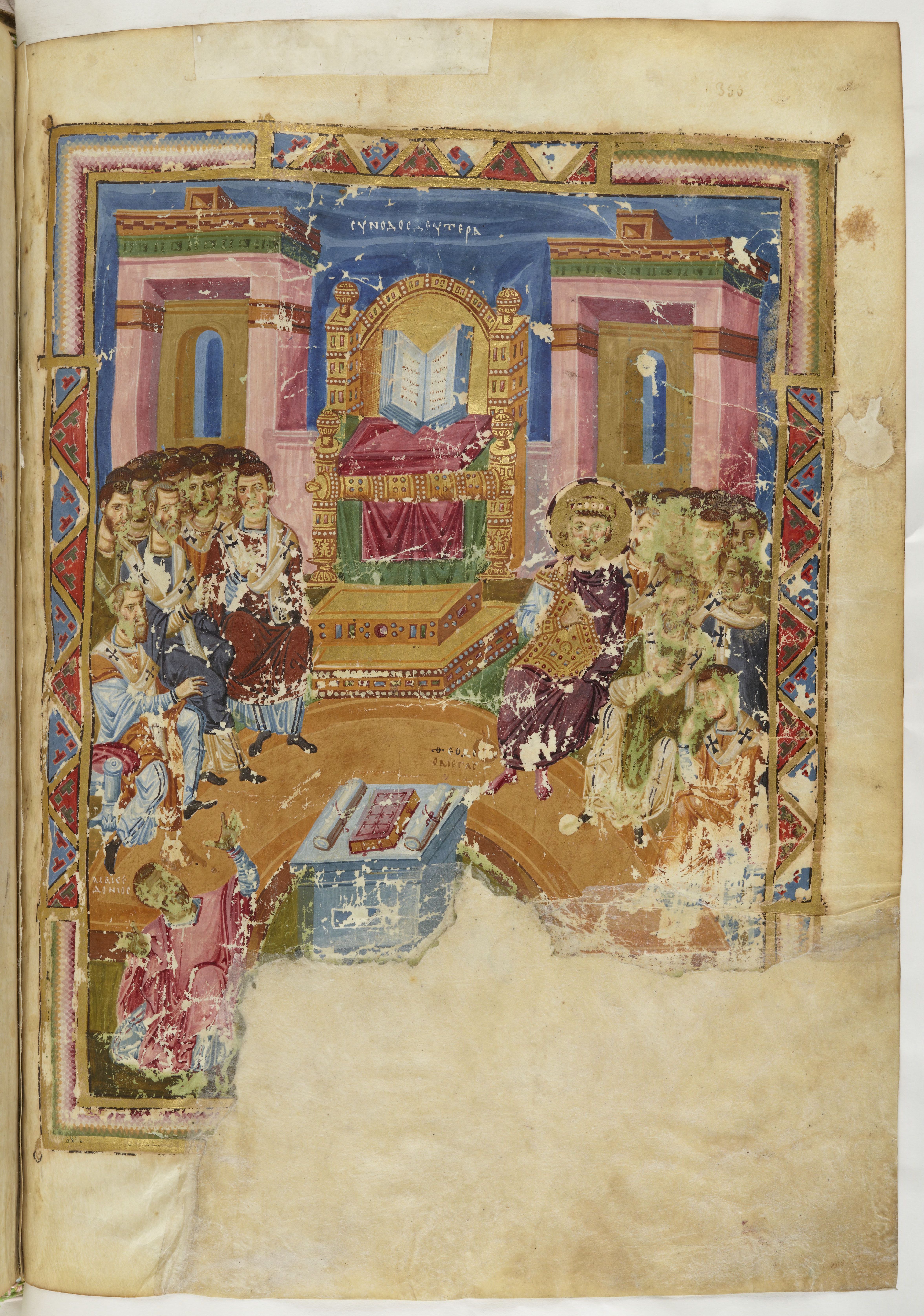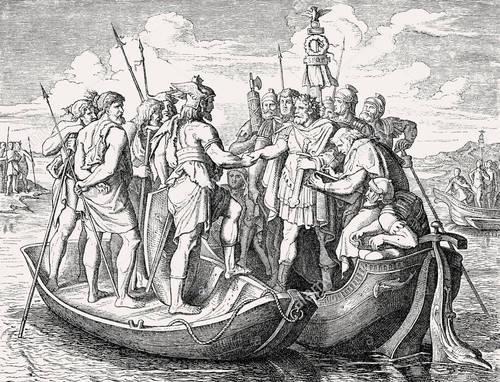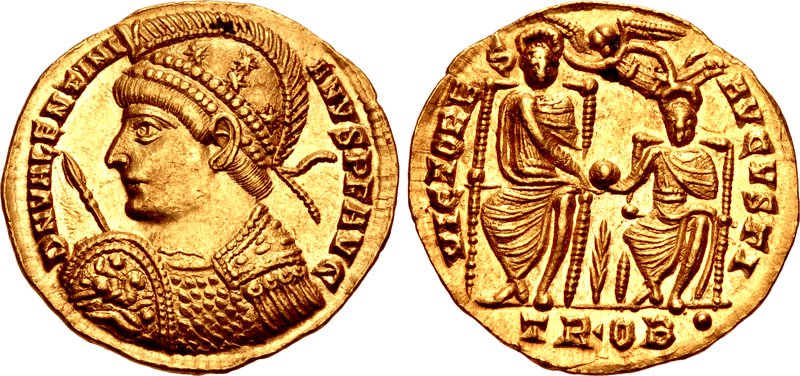|
381
__NOTOC__ Year 381 ( CCCLXXXI) was a common year starting on Friday (link will display the full calendar) of the Julian calendar. At the time, it was known as the Year of the Consulship of Syagrius and Eucherius (or, less frequently, year 1134 ''Ab urbe condita''). The denomination 381 for this year has been used since the early medieval period, when the Anno Domini calendar era became the prevalent method in Europe for naming years. Events By place Roman Empire * Emperor Gratian moves the capital to ''Mediolanum'' (modern-day Milan). Because of his Christian beliefs, he eliminates '' Pontifex Maximus'' as Imperial title. Gratian also refuses the robe of office, insulting the pagan aristocrats of Rome. * The Gallic city of Cularo is renamed Gratianopolis (later Grenoble), in honor of Gratian having created a bishopric. Europe * The Visigothic chieftain Athanaric becomes the first foreign king to visit the Eastern Roman capital of Constantinople. He negotiates a peace ... [...More Info...] [...Related Items...] OR: [Wikipedia] [Google] [Baidu] |
Nicene Creed
The original Nicene Creed (; grc-gre, Σύμβολον τῆς Νικαίας; la, Symbolum Nicaenum) was first adopted at the First Council of Nicaea in 325. In 381, it was amended at the First Council of Constantinople. The amended form is also referred to as the Nicene Creed, or the Niceno-Constantinopolitan Creed for disambiguation. The Nicene Creed is the defining statement of belief of Nicene or mainstream Christianity and in those Christian denominations that adhere to it. The Nicene Creed is part of the profession of faith required of those undertaking important functions within the Orthodox and Catholic Churches. Nicene Christianity regards Jesus as divine and "begotten of the Father". Various non-Nicene doctrines, beliefs, and creeds have been formed since the fourth century, all of which are considered heresies by adherents of Nicene Christianity. In Western Christianity, the Nicene Creed is in use alongside the less widespread Apostles' Creed. In musical setting ... [...More Info...] [...Related Items...] OR: [Wikipedia] [Google] [Baidu] |
First Council Of Constantinople
The First Council of Constantinople ( la, Concilium Constantinopolitanum; grc-gre, Σύνοδος τῆς Κωνσταντινουπόλεως) was a council of Christian bishops convened in Constantinople (now Istanbul, Turkey) in AD 381 by the Roman Emperor Theodosius I. This second ecumenical council, an effort to attain consensus in the church through an assembly representing all of Christendom, except for the Western Church,Richard Kieckhefer (1989). "Papacy". ''Dictionary of the Middle Ages''. . confirmed the Nicene Creed, expanding the doctrine thereof to produce the Niceno-Constantinopolitan Creed, and dealt with sundry other matters. It met from May to July 381 in the Church of Hagia Irene and was affirmed as ecumenical in 451 at the Council of Chalcedon. Background When Theodosius ascended to the imperial throne in 380, he began on a campaign to bring the Eastern Church back to Nicene Christianity. Theodosius wanted to further unify the entire empire behind the ... [...More Info...] [...Related Items...] OR: [Wikipedia] [Google] [Baidu] |
Athanaric
Athanaric or Atanaric ( la, Athanaricus; died 381) was king of several branches of the Thervingian Goths () for at least two decades in the 4th century. Throughout his reign, Athanaric was faced with invasions by the Roman Empire, the Huns and a civil war with Christian rebels. He is considered the first king of the Visigoths, who later settled in Iberia, where they founded the Visigothic Kingdom. Life Athanaric made his first appearance in recorded history in 369, when he engaged in battle with the Roman emperor Valens and ultimately negotiated a favorable peace for his people. During his reign, many Thervingi had converted to Arian Christianity, which Athanaric vehemently opposed, fearing that Christianity would destroy Gothic culture. According to the report of Sozomen, more than 300 Christians were killed in Athanaric's persecution during the 370s. Fritigern, Athanaric's rival, was an Arian and had the favor of Valens, who shared his religious beliefs. In the early 370s, ... [...More Info...] [...Related Items...] OR: [Wikipedia] [Google] [Baidu] |
Grenoble
lat, Gratianopolis , commune status = Prefecture and commune , image = Panorama grenoble.png , image size = , caption = From upper left: Panorama of the city, Grenoble’s cable cars, place Saint-André, jardin de ville, banks of the Isère , arrondissement = Grenoble , canton = Grenoble-1, 2, 3 and 4 , INSEE = 38185 , postal code = 38000, 38100 , mayor = Éric Piolle , term = 2020–2026 , party = EELV , image flag = Flag of Grenoble.svg , image coat of arms = Coat of Arms of Grenoble.svg , intercommunality = Grenoble-Alpes Métropole , coordinates = , elevation min m = 212 , elevation m = 398 , elevation max m = 500 , area km2 = 18.13 , population = , population date = , population footnotes = , urban pop = 451096 , urban area km2 = 358.1 , u ... [...More Info...] [...Related Items...] OR: [Wikipedia] [Google] [Baidu] |
Theodosius I
Theodosius I ( grc-gre, Θεοδόσιος ; 11 January 347 – 17 January 395), also called Theodosius the Great, was Roman emperor from 379 to 395. During his reign, he succeeded in a crucial war against the Goths, as well as in two civil wars, and recognized the Catholic orthodoxy of Nicene Christians as the Roman Empire's state religion. Theodosius was the last emperor to rule the entire Roman Empire before its administration was permanently split between two separate courts (one western, the other eastern). Born in Hispania, Theodosius was the son of a high-ranking general, Theodosius the Elder, under whose guidance he rose through the ranks of the Roman Army. Theodosius held independent command in Moesia in 374, where he had some success against the invading Sarmatians. Not long afterwards, he was forced into retirement, and his father was executed under obscure circumstances. Theodosius soon regained his position following a series of intrigues and executions ... [...More Info...] [...Related Items...] OR: [Wikipedia] [Google] [Baidu] |
Arianism
Arianism ( grc-x-koine, Ἀρειανισμός, ) is a Christological doctrine first attributed to Arius (), a Christian presbyter from Alexandria, Egypt. Arian theology holds that Jesus Christ is the Son of God, who was begotten by God the Father with the difference that the Son of God did not always exist but was begotten within time by God the Father, therefore Jesus was not coeternal with God the Father. Arius's trinitarian theology, later given an extreme form by Aetius and his disciple Eunomius and called anomoean ("dissimilar"), asserts a total dissimilarity between the Son and the Father. Arianism holds that the Son is distinct from the Father and therefore subordinate to him. The term ''Arian'' is derived from the name Arius; it was not what the followers of Arius's teachings called themselves, but rather a term used by outsiders. The nature of Arius's teachings and his supporters were opposed to the theological doctrines held by Homoousian Christians, regard ... [...More Info...] [...Related Items...] OR: [Wikipedia] [Google] [Baidu] |
Christianity
Christianity is an Abrahamic monotheistic religion based on the life and teachings of Jesus of Nazareth. It is the world's largest and most widespread religion with roughly 2.38 billion followers representing one-third of the global population. Its adherents, known as Christians, are estimated to make up a majority of the population in 157 countries and territories, and believe that Jesus is the Son of God, whose coming as the messiah was prophesied in the Hebrew Bible (called the Old Testament in Christianity) and chronicled in the New Testament. Christianity began as a Second Temple Judaic sect in the 1st century Hellenistic Judaism in the Roman province of Judea. Jesus' apostles and their followers spread around the Levant, Europe, Anatolia, Mesopotamia, the South Caucasus, Ancient Carthage, Egypt, and Ethiopia, despite significant initial persecution. It soon attracted gentile God-fearers, which led to a departure from Jewish customs, and, a ... [...More Info...] [...Related Items...] OR: [Wikipedia] [Google] [Baidu] |
Cularo
Cularo was the name of the Gallic city which evolved into modern Grenoble, until 381 when it was renamed Gratianopolis in honor of Roman emperor Gratian. The first reference to Grenoble dates back to July 43 BC.''Ad Familiares'', 10, 2Letter 876/ref> At that time, the small town was called Cularo and had been founded by the Gallic people known as the Allobroges. In 292 the western emperor Maximian built walls around the town after elevating it to the rank of “city”. These Gallo-Roman walls protected the urban area and served as a status of Civitas. The vestiges of the Gallo-Roman wall are now a landmark of this era. In 381, wishing to thank and honor the emperor Gratian Gratian (; la, Gratianus; 18 April 359 – 25 August 383) was emperor of the Western Roman Empire from 367 to 383. The eldest son of Valentinian I, Gratian accompanied his father on several campaigns along the Rhine and Danube frontiers and wa ... for having created there a bishopric, the inhabitants o ... [...More Info...] [...Related Items...] OR: [Wikipedia] [Google] [Baidu] |
Gratian
Gratian (; la, Gratianus; 18 April 359 – 25 August 383) was emperor of the Western Roman Empire from 367 to 383. The eldest son of Valentinian I, Gratian accompanied his father on several campaigns along the Rhine and Danube frontiers and was raised to the rank of ''Augustus'' in 367. Upon the death of Valentinian in 375, Gratian took over government of the west while his half-brother Valentinian II was also acclaimed emperor in Pannonia. Gratian governed the western provinces of the empire, while his uncle Valens was already the emperor over the east. Gratian subsequently led a campaign across the Rhine, attacked the Lentienses, and forced the tribe to surrender. That same year, the eastern emperor Valens was killed fighting the Goths at the Battle of Adrianople, which led to Gratian elevating Theodosius to replace him in 379. Gratian favoured Nicene Christianity over traditional Roman religion, issuing the Edict of Thessalonica, refusing the office of '' pontifex maximus'' ... [...More Info...] [...Related Items...] OR: [Wikipedia] [Google] [Baidu] |





